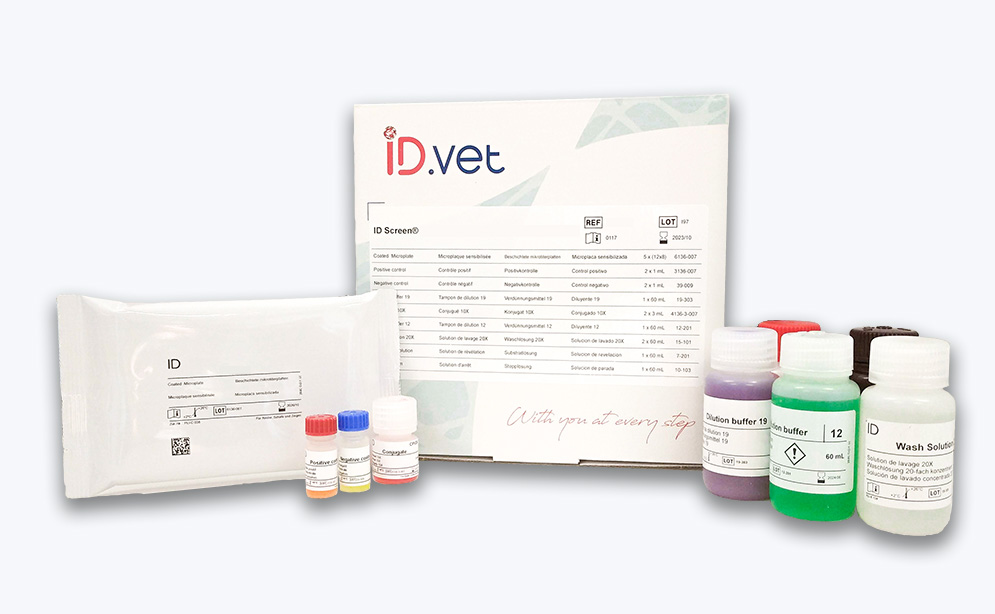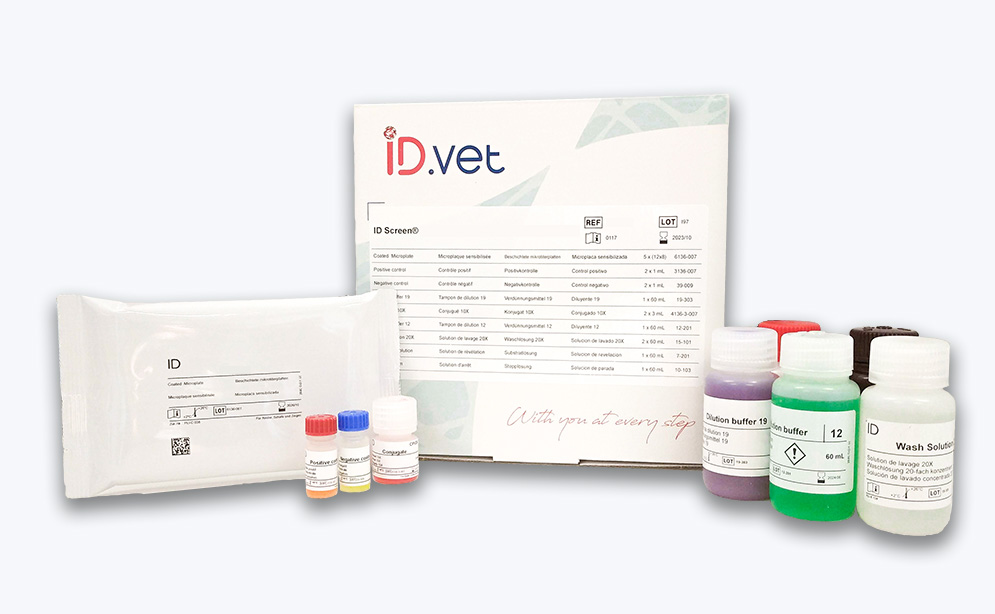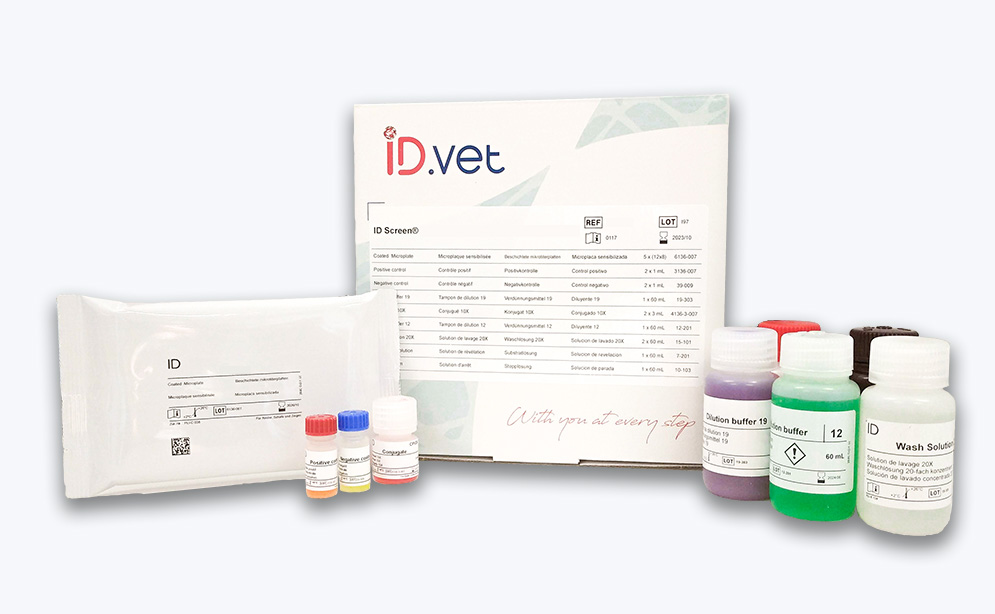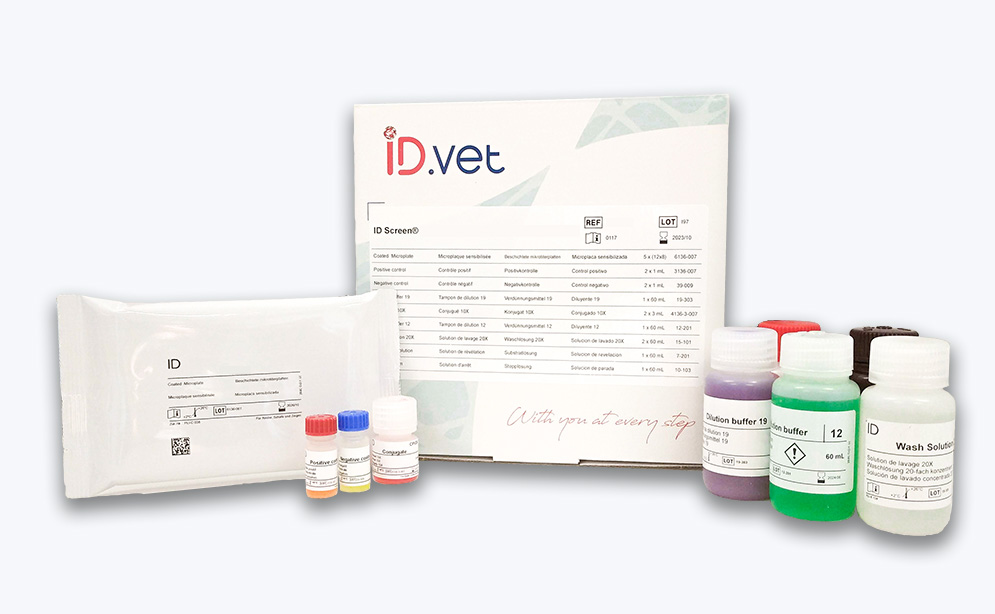ID Screen® CCHF Double Antigen Multi-species dựa trên cơ chế ELISA kháng nguyên kép để phát hiện kháng thể chống lại virus sốt xuất huyết Crimean-Congo (CCHFV) ở gia súc, cừu, dê hoặc các loài nhạy cảm khác, bao gồm cả con người*.
Ưu điểm nổi trội:
- ELISA thương mại duy nhất để phát hiện kháng thể CCHFV đa loài
- Kết quả đáng tin cậy đã được chứng minh tại chuồng trại:
- Độ đặc hiệu tuyệt vời (100%) và độ nhạy (98,9%) trên nhiều loài
- Thỏa thuận cao với VNT và độ nhạy phân tích vượt trội đối với
- Xét nghiệm miễn dịch huỳnh quang (IFA)
- Đã được chứng minh là không có phản ứng chéo với virus Hazara, virus Dugbe và virus gây bệnh ở cừu Nairobi
- Thuận tiện và linh hoạt
- ELISA dựa trên tái tổ hợp có nghĩa là xét nghiệm có thể diễn ra bên ngoài các cơ sở ngăn chặn cao
- Thuốc thử sẵn sàng sử dụng
Đặc tính kỹ thuật:
| Thông số |
Nội dung |
| Phương pháp |
ELISA kháng nguyên kép |
| Loài |
Động vật nhai lại và các loài nhạy cảm khác. Chỉ sử dụng cho nghiên cứu trên mẫu người: xem Tài liệu tham khảo |
| Nền mẫu |
Mẫu huyết thanh, huyết tương và giấy lọc máu |
| Kháng thể cộng hợp |
nucleoprotein CCHFV tái tổ hợp cộng hợp HRP đông khô (đậm đặc 10X) |
Thông tin đóng gói sản phẩm:
| Mã sản phẩm |
Đóng gói |
Số lượng phản ứng |
Dạng đĩa |
| CCHFDA-2P |
2 đĩa |
192 |
12 x 8 giếng |
| CCHFDA-5P |
5 đĩa |
480 |
12 x 8 giếng |
Tài liệu trích dẫn:
RUMINANTS
- Atim S.A. et al. (2023). Prevalence of Crimean-Congo haemorrhagic fever in livestock following a confirmed human case in Lyantonde district, Uganda. Parasites & Vectors, 16(1), 1-10.
- Babaoglu A. R. et al. (2023). Crimean-Congo Hemorrhagic Fever Virus Infection in Domestic Ruminants in Van Province, a Non-endemic Region in Turkey. Indian Journal of Animal Research, 1, 6.
- Matthews J. et al. (2023). Serological Prevalence of Crimean–Congo Hemorrhagic Fever Virus Infection in Small Ruminants and Cattle in The Gambia. Pathogens, 12, 749.
- Simo Tchetgna H. et al. (2023). Molecular and serological evidence of Crimean-Congo hemorrhagic fever orthonairovirus prevalence in livestock and ticks in Cameroon. Front. Cell. Infect. Microbiol. 13:1132495.
- Bratuleanu B. et al. (2022). Seroprevalence of Crimean-Congo Hemorrhagic Fever Among Small Ruminants from Southern Romania. Vector-Borne and Zoonotic Diseases, 22(7), 397-401.
- Duscher G. G. et al. (2022). Hyalomma spp. in Austria—The Tick, the Climate, the Diseases and the Risk for Humans and Animals. Microorganisms, 10(9), 1761.
- Dzikwi-Emennaa A.A. et al. (2022). Detection of Crimean-Congo Hemorrhagic Fever Virus Antibodies in Cattle in Plateau State, Nigeria. Viruses 2022, 14, 2618.
- Fanelli A. et al. (2022). First serological evidence of Crimean–Congo haemorrhagic fever virus in transhumant bovines in Italy. Transboundary and Emerging Diseases.
- González Gordon L. et al. (2022). Seroepidemiology of Crimean-Cong Haemorrhagic Fever among cattle in Cameroon: Implications from a One Health perspective. PLoS Neglected Tropical Diseases, vol. 16, no. 3, e0010217.
- Lule S. A. et al. (2022). Widespread exposure to Crimean-Congo haemorrhagic fever in Uganda might be driven by transmission from Rhipicephalus ticks: Evidence from cross-sectional and modelling studies. Journal of Infection, 85(6), 683-692.
- Lysholm S. et al. (2022). Seroepidemiology of selected transboundary animal diseases in goats in Zambia. Preventive Veterinary Medicine, 206, 105708.
- Satrovic L. et al. (2022). First evidence of Crimean‐Congo haemorrhagic fever virus circulation in Bosnia and Herzegovina. Veterinary Medicine and Science, 8(3), 1271-1275.
- Zhabari Z. and Xhekaj B. (2022). Serological data suggest the spread of Crimean-Congo hemorrhagic fever virus in domestic animals in Kosovo-a short communication. Veterinarski arhiv, 92(2), 155-160.
- Altaliby M. A. S. et al. (2021). Seroprevalence Of Crimean-Congo Haemorrhagic Fever In Sheep And Goats In Iraq. Bulgarian Journal of Veterinary Medicine, ISSN 1311-1477.
- Balinandi S. et al. (2021). Serological and molecular study of Crimean-Congo Hemorrhagic Fever Virus in cattle from selected districts in Uganda. Journal of Virological Methods 290, 114075.
- Blanco-Penedo I. et al. (2021). Seroepidemiology of Crimean-Congo Hemorrhagic Fever Virus (CCHFV) in Cattle across Three Livestock Pastoral Regions in Kenya. Dairy 2, 425–434.
- Esmaeel S.A. et al. (2021). Seroprevalence of Crimean Congo Hemorrhagic Fever in cows by ELISA in Mosul city. Iraqi Journal of Veterinary Sciences, Vol. 35, No. 4 (803-807).
- Hartlaub J. et al. (2021). Cross-Reaction or Co-Infection? Serological Discrimination of Antibodies Directed against Dugbe and Crimean-Congo Hemorrhagic Fever Orthonairovirus in Nigerian Cattle. Viruses 13, 1398.
- Hartlaub J. et al. (2021). Deciphering Antibody Responses to Orthonairoviruses in Ruminants. Microorganisms 2021, 9, 1493.
- Khbou M.K. et al. (2021). Presence of antibodies to Crimean Congo haemorrhagic fever virus in sheep in Tunisia, North Africa. VetMed Sci. 1–7.
- Obanda V. et al. (2021). Livestock Presence Influences the Seroprevalence of Crimean Congo Hemorrhagic Fever Virus on Sympatric Wildlife in Kenya. Vector-Borne And Zoonotic Diseases, Volume 21, Number 10.
- Phonera M. C. et al. (2021). Seroprevalence and Risk Factors of Crimean-Congo Hemorrhagic Fever in Cattle of Smallholder Farmers in Central Malawi. Pathogens 10, 1613.
- Zouaghi K. et al. (2021). First Serological Evidence of Crimean-Congo Hemorrhagic Fever Virus and Rift Valley Fever Virus in Ruminants in Tunisia. Pathogens, 10-769.
- Grech-Angelini S. et al. (2020). Crimean-Congo Hemorrhagic Fever Virus Antibodies among Livestock on Corsica, France, 2014–2016. Emerging Infectious Diseases; 26(5):1041-1044.
- Hartlaub J. et al. (2020). Sheep and Cattle Are Not Susceptible to Experimental Inoculation with Hazara Orthonairovirus, a Tick-Borne Arbovirus Closely Related to CCHFV. Microorganisms 8, 1927.
CAMELIDS
- Lado S. et al. (2022). Crimean–Congo Hemorrhagic Fever Virus Past Infections Are Associated with Two Innate Immune Response Candidate Genes in Dromaderies. Cells, 11-8.
- Camp J.V. et al. (2021). Association of Dromedary Camels and Camel Ticks with Reassortant Crimean-Congo Hemorrhagic Fever Virus, United Arab Emirates. Emerging Infectious Diseases, Vol. 27, No. 9.
- Bouaicha F. et al. (2020). Epidemiological investigation of Crimean-Congo haemorrhagic fever virus infection among the one-humped camels (Camelus dromedarius) in southern Tunisia. Ticks and Tick-borne Diseases, Vol 12, Issue 1.
- Zohaib A. et al. (2020). Crimean-Congo Hemorrhagic Fever Virus in Humans and Livestock, Pakistan, 2015–2017. Emerging Infectious Diseases 26 (4).
DOGS AND HORSES
- Vila M. et al. (2023). Zoonotic findings of Hyalomma marginatum in northwestern Spain: horse serological response and human captures. Poster presented at the EVPC meeting, 29-30 June 2023, Maison-Alfort, France.
- Atim S.A. et al. (2022). Risk factors for Crimean-Congo Haemorrhagic Fever (CCHF) virus exposure in farming communities in Uganda. Journal of Infection, 85(6), 693-701.
- Mangombi J.B. et al.(2020). Seroprevalence of Crimean-Congo Hemorrhagic Fever in Domesticated Animals in Northwestern Senegal. Vector-Borne And Zoonotic Diseases, DOI: 20. 10.1089/vbz.2019.2592.
WILDLIFE
- BAZ-FLORES S. et al. (2024). Mapping the risk of exposure to Crimean-Congo haemorrhagic fever virus in the Iberian Peninsula using Eurasian wild boar (Sus scrofa) as a model. Ticks and Tick-borne Diseases, vol. 15, no 1, p. 102281.
- Cuadrado-Matias R. et al. (2021). The spatiotemporal dynamics of Crimean-Congo haemorrhagic fever virus in enzootic Iberian scenarios. Poster presented at the Virtual 69th WDA /14th EWDA 2021 Joint Conference Cuenca, Spain.
- Espunyes J. et al. (2021). Hotspot of Crimean-Congo Hemorrhagic Fever Virus Seropositivity in Wildlife, Northeastern Spain. Emerging Infectious Diseases, Vol. 27, No. 9.
- Peralbo-Moreno A. et al. (2021). Spatial modelling of Hyalomma lusitanicum ticks shape Crimean-Congo haemorrhagic fever virus exposure in Doñana National Park, Spain. Oral presentation at CUENCA 2021, August 31 to September 2, Spain.
HUMANS
- Frías M. et al. (2022). The spatial pattern of human exposure to Crimean–Congo haemorrhagic fever virus is not consistent with red deer-based risk predictions. Transboundary and Emerging Diseases, 1–7.
- Malonga G.A. et al. (2022). Seroprevalence of Crimean-Congo haemorrhagic fever virus among people living with HIV in Brazzaville, Congo and among blood donors in Bamako, Mali. Poster presented at European Society for Clinical Virology, 7-10 September 2022, Manchester, England.
- Matthews J. M. (2022). Sero-epidemiological investigation of Crimean-Congo hemorrhagic fever virus infection in humans and livestock in West Africa. (Doctoral dissertation).
- Negredo A. et al. (2021). Retrospective Identification of Early Autochthonous Case of Crimean-Congo Hemorrhagic Fever, Spain, 2013. Emerging Infectious Diseases Vol. 27, No. 6.
- Sas M.A. et al. (2018). A novel double-antigen sandwich ELISA for the species-independent detection of Crimean-Congo hemorrhagic fever virus-specific antibodies. Antiviral Research 151, 24-26.














_22.png)
